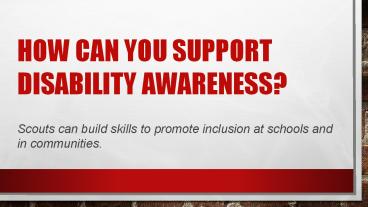Disability Inclusion - PowerPoint PPT Presentation
Title: Disability Inclusion
1
How Can You Support Disability Awareness?
- Scouts can build skills to promote inclusion at
schools and in communities.
2
Lets Get Started
- Introduction
- Why disability inclusion is important to me
- Goals of the presentation
- Learn the difference between physical and
intellectual disabilities - How to promote inclusion, including how to be a
friend to someone with autism - Gain awareness of people first language
- Explore organizations that serve the disabled
3
Physical Versus Intellectual Disability
- Physical Disability a condition (such as an
illness or an injury) that damages or limits a
persons physical abilities. - Examples Loss of Limb, Muscular Dystrophy,
Spinal Cord Injury - A person with a physical disability could be in a
wheel chair, have special braces to help them
walk, or use a walker, they may also use
prosthetics. - Intellectual Disability significant impairment
in intellectual ability accompanied by deficits
in skills necessary for independent daily
functioning - Examples Autism, Downs Syndrome, Cerebral Palsy
(could be both) - A person with an intellectual disability could
require special aides to assist them in everyday
activities.
4
What is Autism?
- Autism spectrum disorder (ASD) is a complex
developmental disability that typically appears
during early childhood. - Autism Spectrum Disorder affects a persons
ability to communicate, and interact with others. - Individuals with Autism Spectrum Disorder
sometimes exhibit behaviors - delayed learning of language
- difficulty making eye contact or holding a
conversation - difficulty with executive functioning, which
relates to reasoning and planning - narrow, intense interests
- poor motor skills and,
- sensory sensitivities.
5
The Acquisition of a Disability
- Disability from birth the person is born with
the disability. Disabilities from birth are
called Congenital Disabilities. - Example Down Syndrome
- Inherited disabilities The disability is a
result of genetic disabilities passed from parent
to offspring. - Example Cystic Fibrosis
- Exposure to disease in womb The mother contracts
a disease, which could cause early labor or
complications in labor causing disability in the
child. - Example Rubella
- Complications in labor Complications while in
Labor could cause disability to the child. - Example Loss of oxygen supply to brain, wrapped
umbilical cord around a limb - Disabilities that appear in early childhood.
- Example Autism, Attention Deficit Disorder
(ADD) - Disabilities are not contagious. However, most
diseases that cause disabilities are treated by
vaccines. Vaccines are very important.
6
What is Autism?
7
How to Be a Friend to Someone with Autism
- Take the Initiative to Include Him or Her
- Find Common Interests
- Be Persistent and Patient
- Communicate Clearly
- Stand Up For Him or Her
- Remember Sensory Sensitivity
- Give Feedback
- Dont Be Afraid
8
Person First Language
- Person first language is designed to put the
person before the disability. Person first
language gives the person respect, rather than
seeing them only for their disability. - Instead of saying, Hes Autistic, say, He has
Autism. - Instead of saying, Handicapped Parking, say,
Accessible Parking. - Say Cognitively Disabled, instead of, Mentally
Retarded.
9
Eliminate the R Word
10
How can you make a difference?
- Eliminate the, R Word, from your vocabulary,
and correct anyone who says it around you. Take
the pledge by Special Olympics Spread the Word
to End the Word - Start saying, Hi, to the students that are in
Special Education classes, if you see them in a
hallway. Invite a student in special education to
sit with you at lunch. - Charter a club at your school, like I did. Join
a club that includes special education students. - Start volunteering as an Unified Athlete in the
Special Olympics program at your school. - Volunteer for organizations that serve the
disabled in your community. Some organizations
that are active in Central Texas are Special
Olympics, The Autism Society of Central Texas,
Miracle League, Down Syndrome Association of
Central Texas - Contact me if you have any questions at
(512)547-0404 or Brentschaefer_at_sbcglobal.net
11
Sources
- http//www.cyh.com/HealthTopics/HealthTopicDetails
.aspx?p114np306id1874 - http//www.merriam-webster.com/dictionary/disabili
ty - http//www.healthyplace.com/neurodevelopmental-dis
orders/intellectual-disability/types-of-intellectu
al-disabilities-list-and-examples/ - http//www.humanillnesses.com/Behavioral-Health-Br
-Fe/Disability.html - https//www.disabilityisnatural.com/people-first-l
anguage.html - https//www.thearc.org/learn-about/intellectual-di
sability































